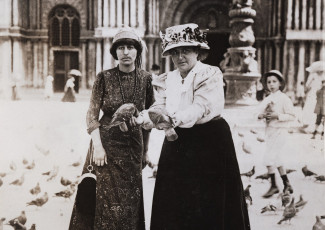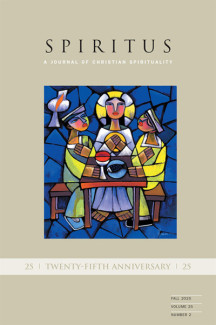
Johns Hopkins UniversityEst. 1876
America’s First Research University
Travel Agent to the (Literary) Stars

Somehow, without quite meaning to, I’ve become a sort of de facto travel agent to the (literary) stars. It all began in 2010 with my sixth book, Lighting Out for the Territory: How Samuel Clemens Headed West and Became Mark Twain, which concerned the transformative half-decade that Twain spent in the mining camps, boomtowns and newspaper offices of the American West, learning to become the writer we know and love today. My follow-up book on Twain’s peripatetic career, American Vandal: Mark Twain Abroad (2015), dealt with the 12 years that Twain and his long-suffering family passed abroad, mostly in Europe but also on the globe-spanning tour of the Pacific that gave birth to his two-volume travel book, Following the Equator. As I noted then, “For a man who enjoyed being called the American, Mark Twain spent a surprising amount of time living and traveling abroad.” He was Huckleberry Finn with a valid passport.
Between my two Twain books I wrote Declaring His Genius: Oscar Wilde in North America, an account of Wilde’s antic 1882 tour of Canada and the United States. No one can spend time in Oscar’s company without laughing out loud at his unsurpassed wit, and I was no exception. I bored my wife, Leslie, to death with daily quotes from the Inimitable Oscar on his quest to bring “the science of beauty” to the United States. Despite being a well-born, Oxford-educated snob, Wilde won over his American audiences with his genuine good nature and surprising—even to him—affection for the United States. “America,” he said, “is not a country; it is a world.” It’s hard to dislike someone who likes your home country as much as Wilde liked America. I liked him back.
All of which brought me around, somewhat full circle, to Gertrude Stein and Alice B. Toklas, native Americans who spent the majority of their lives in self-imposed exile abroad. As a lifelong admirer of Ernest Hemingway—his work, not his lifestyle—I was familiar with Gertrude, Alice and their literary salon at 27 rue de Fleurus on the Left Bank in Paris. Like many readers, my first acquaintance with the couple came via Hemingway’s beautifully written but factually challenged memoir, A Moveable Feast. Since that book appeared decades after the bitter breakup of Hemingway’s friendship with Gertrude (he and Alice were never friends), it presented a very one-sided view of a relationship that for a time, at least, was very important to the young Hemingway.
Despite their difference in age (Gertrude was 25 years older) and sexual orientation (Gertrude was gay), the two writers hit it off from the start. Both in their way were fanatically dedicated artists, and the more openly experimental Gertrude encouraged Hemingway to focus closely and concretely on words: one word, clause or sentence at a time. Through access to her wonderful collection of modern art—Matisse, Degas, Renoir, Cezanne, Gauguin, Toulouse-Lautrec, and Picasso, among many others—she literally opened Hemingway’s eyes to a new way of seeing the world. When he went back to his famous room above a Montmartre sawmill to write the terse, tense, beautifully controlled sentences that would revolutionize 20th-century literature, he had already enjoyed a master’s-level course on writing at the feet of Gertrude Stein.

As I began looking more closely at Gertrude and Alice as possible subjects for a new book, it quickly became clear that there was a good deal more to them than Hemingway’s narrow, slanted account in A Moveable Feast. To begin with, they were very funny—a particular plus for someone who had written in the past about such master wits as Mark Twain, Oscar Wilde, and Ambrose Bierce. Gertrude liked to laugh, even occasionally at herself, and Alice was a champion purveyor of side-eyed, corner-of-the-mouth one-liners. (When Gertrude complained that it was difficult to hear someone else talk about writing, Alice muttered, “That depends on who you are.” And when novelist James Branch Cabell allowed that learning that Gertrude was serious about writing put her in a different light, Alice immediately retorted, “For you, not for me.”) It would be too much to say that neither woman suffered fools: they suffered many in the course of their wide-ranging lives, but they suffered them selectively.
My new book, Gertrude Stein Has Arrived: The Homecoming of a Literary Legend, (Johns Hopkins University Press, 2019) follows Gertrude and Alice on their 1934-35 tour of the United States to promote Gertrude’s surprise best-seller, The Autobiography of Alice B. Toklas. The joke, of course, was that Alice Toklas’s supposed autobiography was actually written by Gertrude Stein. As Huck Finn says about “Mr. Mark Twain” and The Adventures of Tom Sawyer, Gertrude “told the truth, mainly,” but with “some stretchers” thrown in. And until the last sentence of the last paragraph of the last page of her book, she maintained the fiction that Alice had written it. (Some critics—or victims—would claim that the entire book was fiction. Luckily for Gertrude, they were in the minority.)
Like Oscar Wilde 50 years before them, Gertrude and Alice were surprised and touched by their warm reception in America and their reflowering affection for their home country, which neither had seen in more than three decades. “I never knew it was so beautiful,” Gertrude said about America. “I was like a bachelor who goes along fine for twenty-five years and then decides to get married.” And even the more reserved Alice conceded that their American tour had been “an experience and adventure which nothing that might follow would ever equal.” In slightly less than seven months, the couple crisscrossed America, from New England to California, from Minnesota to Texas, stopping along the way at 37 different cities. Everywhere they went they were treated like everyone’s favorite maiden aunts—colorful and eccentric, it was true, but also game, spunky and imminently approachable. As the saying goes, they were up for anything.
In the context of today’s supposedly more “woke” social environment, Gertrude and Alice’s matter-of-fact approach to their same-sex relationship was particularly refreshing. As with every aspect of their lives, they simply did what they wished, when they wished, without reference to or undue concern about the opinions of others. And because they didn’t make a big deal about their relationship, the media and the public didn’t make a big deal about it either. They lived life on their own terms. In these overly contentious, hypersensitive, outrage-trafficking days, there is a great deal to be said for that, and for them.
Roy Morris Jr. is the author of nine books on American history and literature, including Gertrude Stein Has Arrived: The Homecoming of a Literary Legend, now available from Johns Hopkins University Press. He resides in his hometown of Chattanooga, Tennessee.


